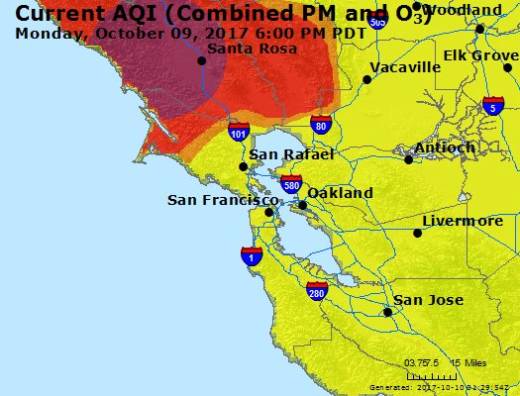A smoke advisory remains in effect for the 7.4 million residents who live in the nine-county Bay Area. The Bay Area Air Quality Management District advised people to limit outdoor activities and adjust air-conditioning units and car vent systems to re-circulate air and prevent outside air from coming inside. In homes without air conditioning, people should keep doors and windows closed, which can reduce pollutant levels by 50%.
Real-time data on local air quality can be found by entering your zip code at AirNow.gov. The EPA-backed website crunches data from thousands of local air monitors and incorporates weather forecasts to create color-coded maps of ozone and particulate pollution.
Wildfire smoke is a shifting blend of gases and particles, including carbon dioxide, water vapor, carbon monoxide, hydrocarbons and other organic chemicals, nitrogen oxides, and trace minerals. There are thousands of individual compounds, many of them toxic.
But what worries doctors most is the particulate matter in smoke, the tiny bits of feathery ash and dust-like soot, much of it invisible to the eye. They are especially worried about particulate matter less than 10 microns wide, known as PM 10. (By comparison, a human hair is about 60 microns wide). They also dread the subset known as PM 2.5, for particulate matter less than 2.5 microns wide.
“The reason that these are more dangerous is they’re so small,” Blount explained. “They go deep into the lungs, to the alveoli, and the smallest ones can even get into the bloodstream.”
Not to mention that the smallest particles are the lightest, and can travel vast distances on the wind.
The particles first damage the body simply by getting inside of it –- triggering inflammatory reactions that themselves can trigger breathing difficulties, heart attacks and even strokes. Within a few days of smoke exposure, damaged lungs can succumb to bronchitis or pneumonia. In pregnant women, exposure to particulates has been associated with premature birth and low birth weight in infants.
There are other ways that vulnerable patients can be proactive about protecting their lungs, said Dr. Naureen Shaikh, who runs a family medicine practice in Sausalito. She recommends purchasing particulate respirator masks that can filter out fine particles – these must be rated N95 or P100.
“You don’t want to use bandannas or towels, those are not going to work,” she said.
Neither will surgical masks or the single-strap “dust masks” that people use to avoid large particles like sawdust.
Shaikh gave out 50 respirator masks at her office on Monday, then visited ten homebound seniors by car, dropping off additional masks for them and their caretakers. Although these respirators can be found online or at home repair stores, she’d like them to be more widely available.
“I think grocery stores should have them, and CVS stores,” Shaikh said. “I stopped off at two stores and couldn’t find the proper mask. I actually found one at a hardware store.”
But particulate respirators have their drawbacks, too. They only filter particles, not combustion-related gases such as carbon monoxide. They don’t make them for small children, and they don’t work very well if they don’t fit closely against the face. Physicians and nurses use them when treating patients with tuberculosis, but each of them undergoes a fitting session at the the hospital, according to Dr. Blount.
Blount wouldn’t recommend them for any sort of physical work, either. “The problem with the N95s is they’re really hard to breathe through.” That also means patients with reduced lung capacity might have trouble drawing adequate breaths.
Despite these flaws, Dr. Shaikh recommends adding the respirators to disaster-preparedness kits. “These forest fires are not going to be decreasing in frequency,” she said.
